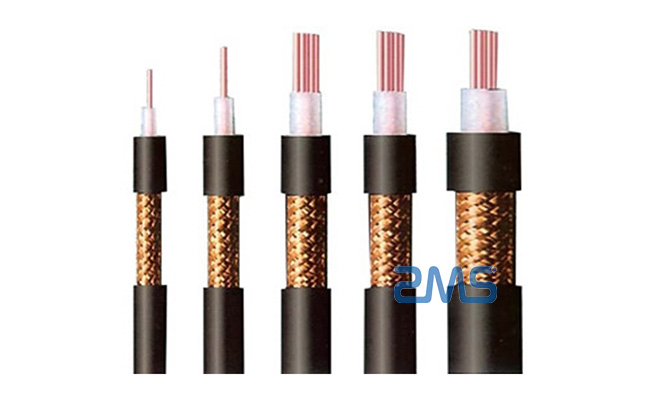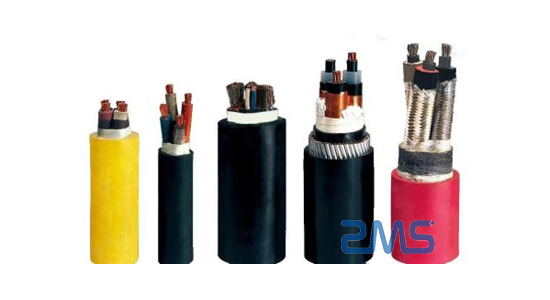Cables are everywhere in our lives, and even the types and models of wires can dazzle everyone. Today, the ZMS cable manufacturer’s editor explains the difference between coaxial cable and ordinary cable.

Coaxial Cable
1. Concentric Cable Description
A coaxial cable is a wire with two concentric conductors, and the conductor and shield share the same axis. The most common coaxial cable consists of copper conductors isolated by insulation material, and outside the inner layer of insulation material is another layer of ring conductor and its insulator, and then the whole line is wrapped by a sheath of PVC or Teflon material.
2. Concentric Cable Classification
Coaxial cable can be divided into two basic types, baseband coaxial cable, and broadband coaxial power cable. At present, the baseband is the commonly used cord, whose shield is made of copper in the form of a mesh with a characteristic impedance of 50; the shield of broadband coaxial cable is usually stamped with aluminum, with a characteristic impedance of 75.
Coaxial cables can be divided into coarse coaxial cables and fine coaxial cables according to their diameter size. Coarse lines are suitable for larger local networks. Since the line does not need to be cut off during installation, it can be flexibly adjusted to the location of the computer in the network as needed, and the overall cost is high.
The thin line is simpler and less expensive to install, but the basic network connectors must be installed at both ends and connected to both ends of the T-connector, so it is easy to create bad potential problems when there are many connectors. This is one of the most common failures of Ethernet in operation today.
3. Coaxial Cable Working Principle
Coaxial cable is divided into four layers from the inside out: a central copper wire, a solid wire containing a single strand or a multi-strand stranded wire, a plastic insulator, a mesh conductive layer, and a wire jacket.
Coaxial cables conduct alternating current rather than direct current, which means that the direction of the current is reversed several times per second.
When a section of a concurrent cable is crushed or twisted, the distance between the central wire and the conductive web is not always the same. This causes the internal radio waves to be reflected by the transmitter, reducing the signal power that can be received.
To overcome this problem, a plastic insulator is added between the central wire and the conductive layer of the mesh to ensure that the distance between them remains constant. This also results in a power line that is relatively straight and not easily bent.
Advantages and disadvantages of coaxial cable.
Its advantage is that it can support high bandwidth communications over relatively long, repeat lines.
And its disadvantages are obvious: First, it is large and takes up a lot of space in the wire duct. The second is that it cannot withstand tangles, stresses, and severe bending, all of which can damage the cord structure and prevent the transmission of signals. The last is the high cost.
4. Parameter Indicators of Coaxial Cable
Coaxial cable is composed of a central conductor, a layer of insulating material, a shielding layer made of mesh fabric, and an external layer of isolating material.
It has enough flexibility to support a bending radius of 254 mm (10 inches). The center conductor is a solid core copper wire with a diameter of 2.17mm ± 0.013mm. The insulation material must meet the electrical parameters of the concurrent line. The shield is composed of a metal strip or sheet that meets the transmission impedance and ECM specification description. the shield has an inner diameter of 6.15 mm and an outer diameter of 8.28 mm. the external isolation material is generally polyvinyl chloride (e.g. PVC) or similar material.
The main parameters of the test
– The open circuit of the conductor or shield.
-Short circuit between conductor and shield.
-Conductor grounding situation.
-The short circuit between the shield connectors.

Ordinary Cable
1. Introduction to Ordinary Cable
A cable is usually made of several or several groups of wires (at least two per group) twisted together to form a rope-like wire. Each group of wires is insulated from each other and often twisted around a center, the entire outer wrapped with a highly insulating cover layer. The line has the characteristics of internal energization and external insulation.
2. Classification of Common Cables
Cables are power cables, control cables, compensation cables, shielded cables, high-temperature cables, computer cables, signal cables, coaxial cables, fire-resistant cables, marine cables, mining cables, aluminum cables, and so on. They are all composed of single or multi-stranded wires and insulating layers, which are used to connect circuits, electrical appliances, and so on.
Cables can be divided into DC cables and AC cables according to the system of the photovoltaic power plant, which is classified as follows according to the different uses and usage environment.
2.1 DC cable
-Series lines between modules and components.
-Shunt lines between strings and between strings to the DC distribution box (sink box).
-Cable between DC distribution box to the inverter.
All the above cables are DC cables, which are more often laid outdoors and need to be moisture-proof, sun-proof, cold-proof, heat-proof, UV-proof, and in some special environments, acid and alkali-proof chemicals.
2.2 AC cable
-The connection line from the inverter to a step-up transformer.
-Connecting wire from the step-up transformer to the power distribution unit.
-The connection line from the distribution unit to the grid or the customer.
This part of the power line is an AC load line, indoor environment laying more, can be selected by the general power wire selection requirements.
3. Application of Common Cables
3.1 Power System
Power systems using wire and line products are mainly overhead bare wire, busbar (busbar), power cable (plastic line, oil paper force wire (basically replaced by plastic power cable), rubber cable, overhead insulated cable), branch cord (to replace part of the busbar), electromagnetic wire and electrical equipment wire and cord for power equipment.
3.2 Information Transmission
Wire and wire for information transmission systems are mainly municipal telephone lines, television lines, electronic cables, radio frequency cables, fiber-optic cables, data cables, electromagnetic wires, power communications, or other composite lines, etc.
3.3 Instrumentation System
This part in addition to overhead bare wire almost all other products are used, but mainly power wires, electromagnetic cables, data cords, instrumentation cables, and so on.
The Difference Between Them
The central axis of a coaxial cable is a copper conductor with an additional layer of insulation, outside which is wrapped by a hollow cylindrical mesh copper conductor, with the outermost layer being the insulation. It is compared with twisted pair wire, coaxial cable has strong anti-interference ability, good shielding performance, stable transmission data, and is also inexpensive, and it can be used without being connected to a hub or switch.
Common cable is usually a rope-like cord made of several wires or groups of wires twisted together, each group of wires insulated from each other and often twisted around a center, with a highly insulating cover over the entire exterior. Mostly erected in the air or installed on the ground, underwater, for telecommunications or power transmission.
Common cable is typically made of many or groups of wires each group of at least two twisted together into a rope-like wire, each group of wires insulated from each other and often twisted around a center, the whole outer wrapped with a highly insulating cover. More than erected in the air or installed underground, underwater, for telecommunications or power transmission.
Summary
The above is the difference between the coaxial cable and ordinary wire. ZMS has numerous high-quality wires, the company’s website contains the above two cable details, if necessary, welcome to consult.
—ZMS Cable Group
